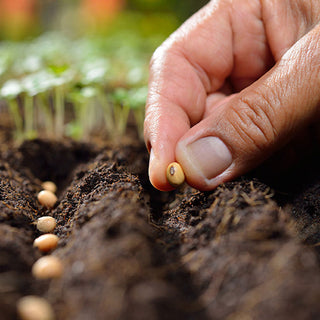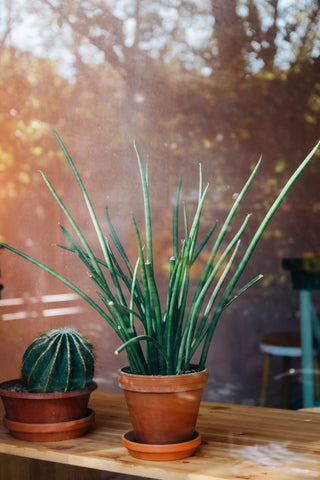Blueberry Seedlings (Sunshine Blue)
- Unit price
- / per
Step into the world of Sunshine Blue – a semi-dwarf, versatile semi-deciduous blueberry that dazzles with its vibrant hot pink flowers, gracefully fading to delicate white in the spring. But that's just the beginning – prepare for a bountiful harvest of juicy, delectable berries.
Sunshine Blue stands tall as a beacon of adaptability, thriving in soils with higher pH levels unlike many of its counterparts. And here's the kicker – it's self-fertile, ensuring a plentiful yield without the need for a partner plant. As a Southern Highbush variety, it boasts a low chilling requirement of just 150 hours, making it a natural fit for subtropical climates. Yet, don't let its tropical origins fool you – Sunshine Blue showcases surprising cold-hardiness, making it a charming addition to patios and gardens even in cooler regions.
Growing Tips for Your Raspberry Seedlings:
-
Location: Choose a sunny spot in your garden with well-draining soil for your blueberry plants. Blueberries thrive in fertile, well-drained soil, so make sure to prepare your planting area accordingly.
-
Planting: When planting your blueberry seedlings, space them according to the recommendations provided. Ensure each plant has enough room to grow and spread out as they mature, typically about 2-3 feet apart in rows with 6-8 feet between rows.
-
Watering: Keep the soil consistently moist, especially during the growing season and dry periods. Aim for about 1-2 inches of water per week, either through rainfall or supplemental watering, ensuring the soil stays evenly moist but not waterlogged.
-
Mulching: Apply a layer of organic mulch, such as straw, compost, or wood chips, around your blueberry plants to conserve moisture, suppress weeds, and regulate soil temperature. Leave a small gap around the main stem to prevent rot and allow air circulation.
We are a proudly Australian-owned family business dedicated to providing high-quality seedlings, seeds, fruit trees, native plants, and indoor ornamentals. We offer express shipping to SA, VIC, QLD, and NSW, with local delivery and pickups available by arrangement. Unfortunately, due to restrictions, we are unable to send to TAS, WA, or NT. For OH&S and biosecurity reasons, farm tours and direct purchases are not available, and pickups can only be made at our farm gate entrance. We deeply value our loyal customers and thank you for your continued support.
Blueberry Seedlings (Sunshine Blue)
- Unit price
- / per
Adding product to your cart
You may also like
Step into the world of Sunshine Blue – a semi-dwarf, versatile semi-deciduous blueberry that dazzles with its vibrant hot pink flowers, gracefully fading to delicate white in the spring. But that's just the beginning – prepare for a bountiful harvest of juicy, delectable berries.
Sunshine Blue stands tall as a beacon of adaptability, thriving in soils with higher pH levels unlike many of its counterparts. And here's the kicker – it's self-fertile, ensuring a plentiful yield without the need for a partner plant. As a Southern Highbush variety, it boasts a low chilling requirement of just 150 hours, making it a natural fit for subtropical climates. Yet, don't let its tropical origins fool you – Sunshine Blue showcases surprising cold-hardiness, making it a charming addition to patios and gardens even in cooler regions.
Growing Tips for Your Raspberry Seedlings:
-
Location: Choose a sunny spot in your garden with well-draining soil for your blueberry plants. Blueberries thrive in fertile, well-drained soil, so make sure to prepare your planting area accordingly.
-
Planting: When planting your blueberry seedlings, space them according to the recommendations provided. Ensure each plant has enough room to grow and spread out as they mature, typically about 2-3 feet apart in rows with 6-8 feet between rows.
-
Watering: Keep the soil consistently moist, especially during the growing season and dry periods. Aim for about 1-2 inches of water per week, either through rainfall or supplemental watering, ensuring the soil stays evenly moist but not waterlogged.
-
Mulching: Apply a layer of organic mulch, such as straw, compost, or wood chips, around your blueberry plants to conserve moisture, suppress weeds, and regulate soil temperature. Leave a small gap around the main stem to prevent rot and allow air circulation.
We are a proudly Australian-owned family business dedicated to providing high-quality seedlings, seeds, fruit trees, native plants, and indoor ornamentals. We offer express shipping to SA, VIC, QLD, and NSW, with local delivery and pickups available by arrangement. Unfortunately, due to restrictions, we are unable to send to TAS, WA, or NT. For OH&S and biosecurity reasons, farm tours and direct purchases are not available, and pickups can only be made at our farm gate entrance. We deeply value our loyal customers and thank you for your continued support.
You may also like
You may also like

CERTIFIED ORGANIC
Commercial-grade certified organic seed boasts top-notch germination rates and yields, perfect for Aussie growers
Testimonials

QPS offers a wide selection of high-quality seedlings, including herbs, vegetables, and ornamental plants. They are known for their robust health and diverse variety, catering to all gardening preferences. With careful packaging and clear care instructions, Quality plants & seedlings ensures their plants arrive in good condition. They prioritise customer service and sustainability, making them a trusted choice for gardeners of all levels aiming to create thriving gardens.

Choosing QPS for my certified organic seeds was a game-changer for my garden. The variety of herbs, vegetables, and ornamental plants available exceeded my expectations, all grown with meticulous organic practices. The seeds arrived promptly and were clearly labeled with planting instructions, making the process smooth and stress-free. I've been impressed with the high germination rates and the healthy growth of the plants, reflecting QPS's commitment to quality. For anyone looking to start or expand an organic garden, QPS is my go-to choice for reliable, sustainable seeds.

Sourcing wholesale indoor plants from QPS has been a fantastic experience for my projects as a landscape designer. Their extensive selection of indoor plants is of exceptional quality, perfect for creating vibrant interior spaces. Each plant arrives well-packaged and in excellent condition, reflecting QPS's attention to detail and commitment to customer satisfaction. Their competitive wholesale pricing makes them a preferred supplier for large-scale projects. I highly recommend Quality Plants & Seedlings to fellow professionals and enthusiasts seeking reliable, top-notch indoor plants for their designs.

Choosing QPS for seedlings at our school has been a great decision. Their diverse range includes everything from vegetables to ornamental plants, all nurtured with care using organic practices. The seedlings arrived promptly and were well-packaged with clear instructions, making them easy for students to handle and plant. We've been pleased with the robust health and rapid growth of the plants, which has enhanced our educational gardening initiatives. QPS's commitment to quality and sustainability makes them an ideal choice for schools looking to cultivate a green thumb in students.






